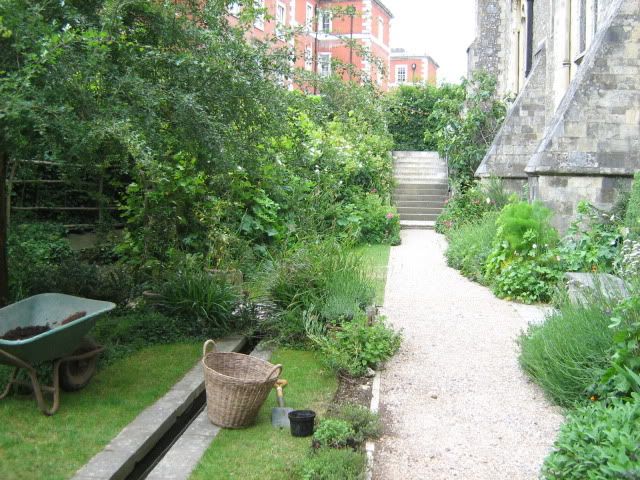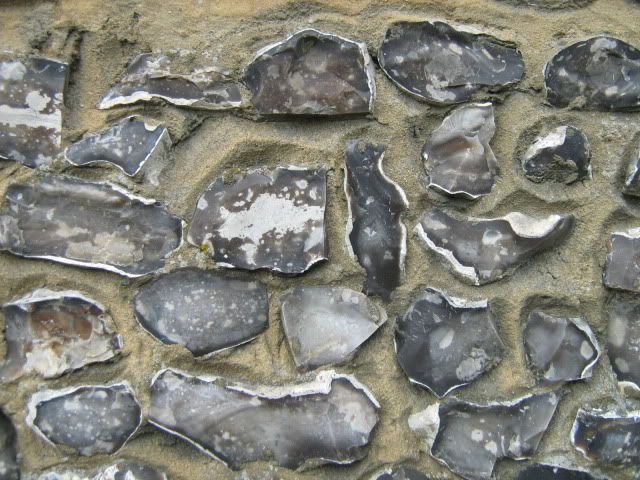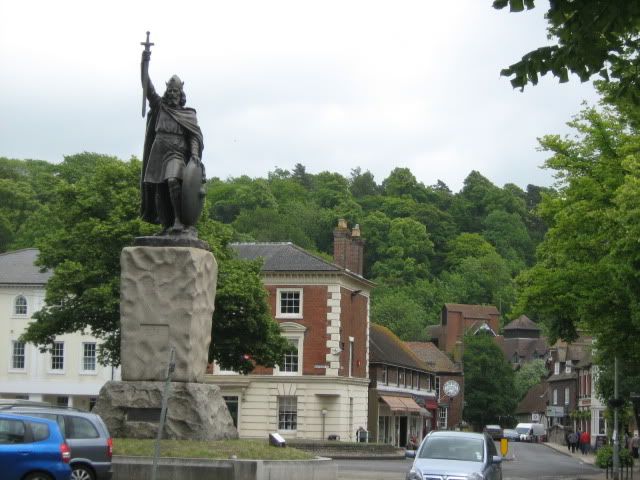Prologue: To Sleep, Perchance to Dream
Day One: The City of Dreaming Spires
Day Two: Eccentric Ramblings
Day Three: A Funny Thing Happened On the Way to the Palace
Monday May 23
Monday was a last-minute improvisation on our parts. The original plan had been to go to Bristol to see the SS Great Britain, but just before we left, we'd found out that there was a new museum opening up, the M-Shed, devoted to the history of Bristol. Just the kind of thing we most like—and it wasn't going to be open until a couple of weeks after we came home. Also, Bristol is all the way over on the west coast, which makes it a much better fit for a trip to Cornwall and Devon. So we decided to save Bristol for another time, and instead went to Winchester.

Winchester is the ancient capital of England, seat of Alfred the Great, among others. It was settled in pre-Roman times, the site of the thriving city of Venta Belgarum under the Romans, and one of the places identified with Camelot. It was the capital of the ancient kingdom of Wessex and the Kingdom of England. It also has a magnificent cathedral, the longest gothic cathedral in Europe.
So, we took the train to Winchester early on Monday morning. We arrived before anything was open, and headed up to the Great Hall of Winchester Castle, the only part of the castle still left standing. It was built in the 12th century. We had a few minutes to walk around looking at the ruins and reading informative plaques (we adore informative plaques, in case I've neglected to mention that lately). The Great Hall opened and we walked around. It's mostly a big empty chamber, notable for its age and history. It was used as a courtroom until relatively modern times. In it hangs the famous 'King Arthur's' Round Table. The table has been dated to the 13th century, and was repainted in the time of Henry VIII. It was taken down in (I believe they said) the 70s for conservation and dating. It turns out to weigh over a ton, which would explain why it has so rarely been moved!

Behind the Great Hall is a recreation of a medieval garden, planted with herbs and flowers common in medieval gardens, with sod seats, and woven withy screens.


I quite liked the scattering of tools. Can't you just imagine the gardener has stepped out for a moment, and will be back any moment?
We had to see the Cathedral of course. It was majestic, immense, solemn and very, very gothic.




We walked around the cathedral, reading the memorials. Though there were plenty to churchmen and dignitaries, the thing that most struck us was the overwhelming number of memorials to fallen soldiers. It's one thing to know they happened, and another to see all the names on the stones. So many wars, so many dead. After seeing the cathedral, we decided against visiting any of the several military museums in Winchester. It was just too sad.

We wanted to finish with a visit to the cathedral library, but it turned out not to be open until afternoon, so we headed back out into the town in search of lunch. We found dueling pasty shops in the center of town. One was a chain we'd encountered before and the other was new, so we checked out the new one. The pasties were quite good- but if I had to judge between the two, I think I'd need to do further taste-testing. Possibly quite a lot of taste-testing. I can't understand why the Cornish pasty hasn't come to American markets yet- it's an excellent fast meal.
After lunch we went to the Winchester City Museum- they have a lovely building:

It also had a number of Roman artifacts, and mosaics in beautiful condition, and we especially liked the series of dioramas showing how the city looked at various points in its history.
We set out in search of the Winchester City Mill, a re-created medieval water-powered mill on the River Itchen, on a site used for milling flour since Saxon times. We did some wandering around before finding it- the river Itchen flows through the center of the city, but Winchester has several other streams as well- legacy of the Romans, who rerouted the waterways to provide better drainage.

The mill had the usual models showing how the mechanisms work, and also examples of earlier grinding technology, such as a quern stone. While I would have been perfectly willing to accept that water-powered mills were superior, a very few minutes with the quern-stone gave me a much better idea of just how laborious it was to grind grain by hand.
We also walked down to stand on a catwalk just above the millrace. The force of the water is quite astonishingly strong there, and the mechanisms are impressively large.

It's also home to a family of otters. They're too shy to come out when people are there, but they have an otter-cam on a motion sensor and you can watch a loop of the otters' activities upstairs.
After exploring the mill, we returned to the cathedral, to see the Cathedral library and scriptorium. The current exhibition was on the King James Bible, and they had many fine old books, but the glory of the collection is the Winchester Bible, a large and fabulously illuminated manuscript. The script was almost entirely done by a single scribe- no doubt the lifework of the man who did it. The bible has remained at Winchester Cathedral for eight hundred years. It had a very close call at the hands of Cromwell's soldiers during the English Civil War, but was fortunately returned to the Cathedral largely undamaged. There are a few bits missing- one illustration is in at the Morgan Library and Museum in New York. But the condition of what is left is amazing. The colors are fabulous- very bright. Although the text is complete, the bible is only partially illustrated- and some illustrations have been sketched in but not completed, providing a valuable insight into the illuminators' techniques. JT compared it to an exhibit we once saw of ancient Egyptian statuary from a sculptor's workshop- seeing the first lines of a sketch, as if the artist set down his tools and went to lunch- is more evocative than seeing the completed work.
After that we took a final stroll around the city. Walking around and soaking up the atmosphere is one of our great pleasures on these trips, as well as noting the details of architecture and scenery that tell us we're Not From Around Here. For example, one of the things I always notice is the ubiquitous flint, seen everywhere from the gravel on the ground to the walls and buildings:

It especially sticks out because flint is not especially common in New England, and in my youthful rock-hunting days, I spent quite a long time searching for a piece for my rock collection. It's quite distinctive-looking, so seeing it everywhere in southern England never fails to strike me as alien and odd.
By this time we were starting to think about dinner, and hadn't spotted any restaurants that especially enticed us. Before catching our train, we took one final walk up to the site of Hyde Abbey, where King Alfred the Great is supposed to have been buried. We found only the tiny church of St. Bartholomew's, and the Hyde Church Path, tucked in between blocks of houses:

We didn't miss seeing Alfred himself, however, as he presides over The Broadway:

And from there we caught a train to London, and our hotel and ultimately to Persian food for dinner before calling it a day.

I've always wondered about descriptions of galloping horses with sparks flying from their horseshod hooves and now I know the secret: flint in the roadwork!
ReplyDeleteWhat a lovely sidetrip that turned out to be. Thanks for sharing it with us.
Wow. Thank you for the vicarious vacation. I do admit to a moment's wonderment at what a giant dartboard was doing in a cathedral but the text quickly tabled that motion.
ReplyDelete